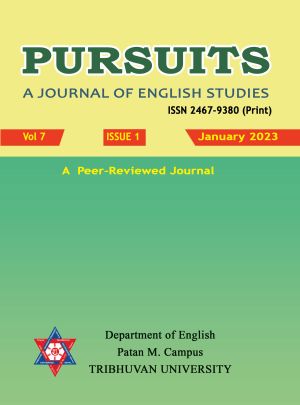Shaileshwarī as the Goddess of Power and Creation in Her Mythological Literature
DOI:
https://doi.org/10.3126/pursuits.v7i1.55372Keywords:
Goddess, Shaileshwarī, Shiva, Pārvatī, Brahmā, Lord Rām, Indian Brāhman, sexAbstract
This paper attempts to highlight the paurānic ("mythical") or religious story of the temple of Goddess Shaileshwarī of Silgadhi, Doti under Seti zone, Nepal with Northrop Frey's theories of Myth Criticism, Archetypal Criticism, and the Quest-Myth so that the people of Nepal and India would know about the temple's mythical and religious importance. By spreading the temple's mythical story in Nepal and India, we could promote the religious tourism of Nepal, especially of the local area. The story of Goddess Shaileshwarī goes back to the Satya Yuga when Shiva and Pārvatī got married as mentioned in the "Mānas Khand" of The Holy Skanda Purān. After Their marriage, They stayed in the temple area to enjoy Their divine honeymoon for some time. Then, Brahmā (the Creator) came to this temple and prayed to Pārvatī, now known as Shaileshwarī or Shilādevī. Similarly, two Indian Brāhmans and Lord Rām―all three from India― visited the temple, worshipped, and prayed to Shiva and Pārvatī, and were blessed by Her in the Tretā Yuga. Shaileshwarī is the Goddess of the universe who fulfils Her devotees' desires. Shiva and Pārvatī are the archetypal symbols or primordial images of creation, destruction, re-creation, power, knowledge, and a sacred sexual union. Every male and female creature is a living embodiment of Shiva and Pārvatī. Also, Shiva and Pārvatī live in each other's body as Ardhanārīshwara ("Lord Shiva whose left part is of Goddess Pārvatī "). So, every male and female is divine and both have each other's qualities, too.




